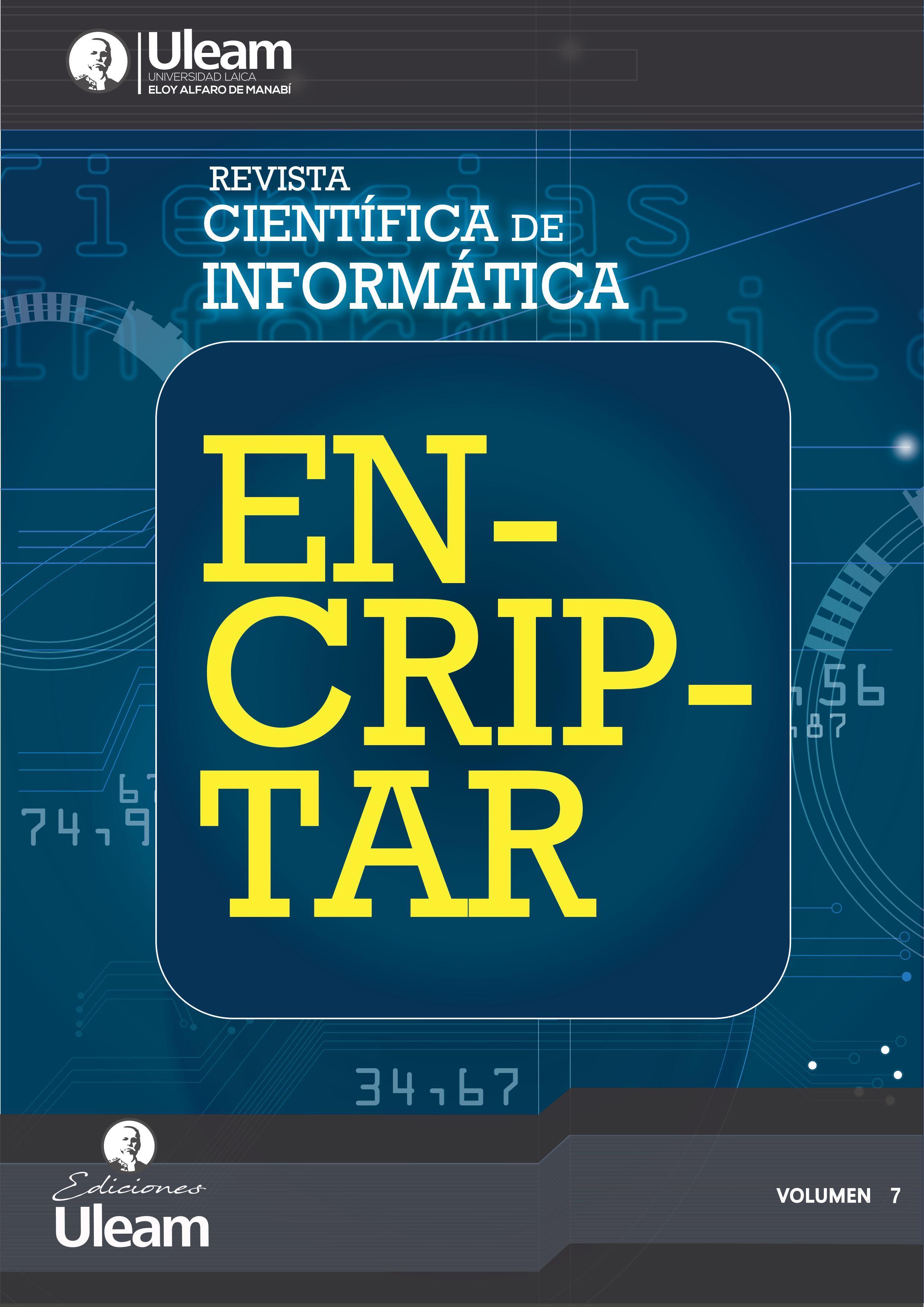Métricas de los Eye – Tracker que se usan en Terapias para Individuos con Trastorno del Espectro Autista: Revisión Sistemática de la Literatura.
DOI:
https://doi.org/10.56124/encriptar.v7i14.001Palabras clave:
Métricas eye – tracker, patrones de seguimiento ocular, algoritmos eye – tracker, TEA eye – tracker, eye – tracker autismoResumen
Actualmente múltiples dispositivos ayudan a mejorar la calidad de vida de sus usuarios, más aún cuando ellos tienen características personalizadas para personas con autismo. El trastorno del espectro autista (TEA) es un trastorno neurobiológico del desarrollo que afecta la comunicación, la interacción social y el comportamiento, existen terapias para individuos con TEA que se realizan utilizando elementos como los eye – tracker. El eye – tracker es un dispositivo diseñado para medir y registrar los movimientos oculares de un individuo por medio de métricas, las cuales proporcionan información detallada sobre el comportamiento visual. Para ellos se analizan los patrones de seguimiento ocular, que se refieren a los movimientos característicos que los ojos de un individuo siguen al explorar y procesar visualmente un estímulo o una escena. Este documento recopila los patrones de seguimiento ocular y las métricas que usan los eye – tracker en terapias para individuos con trastorno del espectro autista. Para ello se ha aplicado una metodología de revisión sistemática de la literatura (SLR), basada en una búsqueda exhaustiva en bibliotecas científicas del campo de la informática .En los resultados se destacan las métricas usadas por los eye – tracker en la mayoría de las terapias para individuos con el TEA, que están fundamentadas en las fijaciones, los movimientos sacádicos y movimientos suaves, además se recalcan los algoritmos basados en inteligencia artificial (IA) que los softwares del eye – tracker utilizan para analizar los datos que se obtienen a partir de las métricas.
Descargas
Citas
Almourad, M. B., & Bataineh, E. (2020). Visual Attention toward Human Face Recognizing for Autism Spectrum Disorder and Normal Developing Children: An Eye Tracking Study. Proceedings of the 2020 The 6th International Conference on E-Business and Applications, 99–104. https://doi.org/10.1145/3387263.3387283
Appel, T., Santini, T., & Kasneci, E. (2016). Brightness- and motion-based blink detection for head-mounted eye trackers. Proceedings of the 2016 ACM International Joint Conference on with an emphasis on machine learning and Internet of Things technologies. Expert Systems with Applications, 166, 114037. https://doi.org/10.1016/j.eswa.2020.114037
Banire, B., Al Thani, D., Qaraqe, M., Mansoor, B., & Makki, M. (2021). Impact of mainstream classroom setting on attention of children with autism spectrum disorder: An eye-tracking study. Universal Access in the Information Society, 20(4), 785–795. https://doi.org/10.1007/s10209-020-00749-0
Banire, B., Al-Thani, D., Qaraqe, M., Khowaja, K., & Mansoor, B. (2020). The Effects of Visual Stimuli on Attention in Children With Autism Spectrum Disorder: An Eye-Tracking Study. IEEE Access, 8, 225663–225674. IEEE Access. https://doi.org/10.1109/ACCESS.2020.3045042
Birawo, B., & Kasprowski, P. (2022). Review and Evaluation of Eye Movement Event Detection Algorithms. Sensors, 22(22), Article 22. https://doi.org/10.3390/s22228810
Bochet, A., Franchini, M., Kojovic, N., Glaser, B., & Schaer, M. (2021). Emotional vs. Neutral Face Exploration and Habituation: An Eye-Tracking Study of Preschoolers With Autism Spectrum Disorders. Frontiers in Psychiatry, 11. https://doi.org/10.3389/fpsyt.2020.568997
Dalrymple, K. A., Wall, N., Spezio, M., Hazlett, H. C., Piven, J., & Elison, J. T. (2018). Rapid face orienting in infants and school-age children with and without autism: Exploring measurement invariance in eye-tracking. PLoS ONE, 13(8), e0202875. https://doi.org/10.1371/journal.pone.0202875
eXavier, J., eVignaud, V., eRuggiero, R., eBodeau, N., eCohen, D., & eChaby, L. (2015). A Multidimensional Approach to the Study of Emotion Recognition in Autism Spectrum Disorders. Frontiers in Psychology, 6. https://doi.org/10.3389/fpsyg.2015.01954
Fixation detection for head-mounted eye tracking based on visual similarity of gaze targets | Proceedings of the 2018 ACM Symposium on Eye Tracking Research & Applications. (s/f). Recuperado el 18 de agosto de 2023, de https://dl.acm.org/doi/10.1145/3204493.3204538
Fletcher-Watson, S., & Hampton, S. (2018). The potential of eye-tracking as a sensitive measure of behavioural change in response to intervention. Scientific Reports, 8(1), Article 1. https://doi.org/10.1038/s41598-018-32444-9
Frazier, T. W., Klingemier, E. W., Parikh, S., Speer, L., Strauss, M. S., Eng, C., Hardan, A. Y., & Youngstrom, E. A. (2018). Development and Validation of Objective and Quantitative Eye Tracking−Based Measures of Autism Risk and Symptom Levels. Journal of the American Academy of Child & Adolescent Psychiatry, 57(11), 858–866. https://doi.org/10.1016/j.jaac.2018.06.023
Fuhl, W., Castner, N., & Kasneci, E. (2018a). Histogram of oriented velocities for eye movement detection. Proceedings of the Workshop on Modeling Cognitive Processes from Multimodal Data, 1–6. https://doi.org/10.1145/3279810.3279843
Fuhl, W., Castner, N., & Kasneci, E. (2018b). Rule-based learning for eye movement type detection. Proceedings of the Workshop on Modeling Cognitive Processes from Multimodal Data, 1–6. https://doi.org/10.1145/3279810.3279844
Gomez, A. R., & Gellersen, H. (2018). Smooth-i: Smart re-calibration using smooth pursuit eye movements. Proceedings of the 2018 ACM Symposium on Eye Tracking Research & Applications, 1–5. https://doi.org/10.1145/3204493.3204585
Hauser, F., Mottok, J., & Gruber, H. (2018). Eye Tracking Metrics in Software Engineering. Proceedings of the 3rd European Conference of Software Engineering Education, 39–44. https://doi.org/10.1145/3209087.3209092
Hochhauser, M., Aran, A., & Grynszpan, O. (2021). Investigating attention in young adults with autism spectrum disorder (ASD) using change blindness and eye tracking. Research in Autism Spectrum Disorders, 84, 101771. https://doi.org/10.1016/j.rasd.2021.101771
Kinsman, T., Evans, K., Sweeney, G., Keane, T., & Pelz, J. (2012). Ego-motion compensation improves fixation detection in wearable eye tracking. Proceedings of the Symposium on Eye Tracking Research and Applications, 221–224. https://doi.org/10.1145/2168556.2168599
Klaib, A. F., Alsrehin, N. O., Melhem, W. Y., Bashtawi, H. O., & Magableh, A. A. (2021). Eye tracking algorithms, techniques, tools, and applications with an emphasis on machine learning and Internet of Things technologies. Expert Systems with Applications, 166, 114037. https://doi.org/10.1016/j.eswa.2020.114037
Kurzhals, K., Hlawatsch, M., Burch, M., & Weiskopf, D. (2016). Fixation-image charts. Proceedings of the Ninth Biennial ACM Symposium on Eye Tracking Research & Applications, 11–18. https://doi.org/10.1145/2857491.2857507
Lahiri, U., Bekele, E., Dohrmann, E., Warren, Z., & Sarkar, N. (2013). Design of a Virtual Reality Based Adaptive Response Technology for Children With Autism. IEEE Transactions on Neural Systems and Rehabilitation Engineering, 21(1), 55–64. https://doi.org/10.1109/TNSRE.2012.2218618
Li, B., Wang, Q., Barney, E., Hart, L., Wall, C., Chawarska, K., de Urabain, I. S., Smith, T. J., & Shic, F. (2016). Modified DBSCAN algorithm on oculomotor fixation identification. Proceedings of the Ninth Biennial ACM Symposium on Eye Tracking Research & Applications, 337–338. https://doi.org/10.1145/2857491.2888587
Martínez, L. (2021). Casos exploratorios aplicados a partir de distintos diseños metodológicos: Eye-tracking fijo y online. Comunicación & Métodos, 3(2), Article 2. https://doi.org/10.35951/v3i2.136
Morales, A., Costela, F. M., Tolosana, R., & Woods, R. L. (2018). Saccade Landing Point Prediction: A Novel Approach based on Recurrent Neural Networks. Proceedings of the 2018 International Conference on Machine Learning Technologies, 1–5. https://doi.org/10.1145/3231884.3231890
Munn, S. M., Stefano, L., & Pelz, J. B. (2008). Fixation-identification in dynamic scenes: Comparing an automated algorithm to manual coding. Proceedings of the 5th symposium on Applied perception in graphics and visualization, 33–42. https://doi.org/10.1145/1394281.1394287
Muratori, F., Billeci, L., Calderoni, S., Boncoddo, M., Lattarulo, C., Costanzo, V., Turi, M., Colombi, C., & Narzisi, A. (2019). How Attention to Faces and Objects Changes Over Time in Toddlers with Autism Spectrum Disorders: Preliminary Evidence from An Eye Tracking Study. Brain Sciences, 9(12), Article 12. https://doi.org/10.3390/brainsci9120344
Rapid alternating saccade training | Proceedings of the 2018 ACM Symposium on Eye Tracking Research & Applications. (s/f). Recuperado el 19 de agosto de 2023, de https://dl.acm.org/doi/10.1145/3204493.3204588
Robain, F., Kojovic, N., Solazzo, S., Glaser, B., Franchini, M., & Schaer, M. (2021). The impact of social complexity on the visual exploration of others’ actions in preschoolers with autism spectrum disorder. BMC Psychology, 9(1), 1–15. https://doi.org/10.1186/s40359-021-00553-2
Rosa, A. D. (2022, febrero 28). Application of Eye-tracking in research on the theory of mind in ASD. European Review. https://www.europeanreview.org/article/28129
Sanchez, M. (2022, abril 7). La tecnología como ayuda para los niños con TEA. Atlantic International Technology. https://www.atlantic.es/blog/la-tecnologia-como-ayuda-para-los-ninos-con-tea/
Sanromà-Giménez, M., Lázaro-Cantabrana, J. L., & Gisbert-Cervera, M. (2018). El papel de las tecnologías digitales en la intervención educativa de niños con trastorno del espectro autista. RiiTE Revista Interuniversitaria de Investigación en Tecnología Educativa. https://doi.org/10.6018/riite/2018/327991
Santini, T., Fuhl, W., Kübler, T., & Kasneci, E. (2016). Bayesian identification of fixations, saccades, and smooth pursuits. Proceedings of the Ninth Biennial ACM Symposium on Eye Tracking Research & Applications, 163–170. https://doi.org/10.1145/2857491.2857512
Sasson, N. J., & Elison, J. T. (2012). Eye Tracking Young Children with Autism. JoVE (Journal of Visualized Experiments), 61, e3675. https://doi.org/10.3791/3675
Schwartzman, J. S., Velloso, R. de L., D’Antino, M. E. F., & Santos, S. (2015). The eye-tracking of social stimuli in patients with Rett syndrome and autism spectrum disorders: A pilot study. Arquivos de Neuro-Psiquiatria, 73, 402–407. https://doi.org/10.1590/0004-282X20150033
SciELO - Brasil—Saccadic movements using eye-tracking technology in individuals with autism spectrum disorders: Pilot study Saccadic movements using eye-tracking technology in individuals with autism spectrum disorders: Pilot study. (s/f). Recuperado el 26 de agosto de 2023, de https://www.scielo.br/j/anp/a/Db95r6fvqWKKQmxKGZNBZ8b/?lang=en
Serrano Baraja, A. L. (2022). Revisión sociohistórica del concepto de autismo y sus implicaciones epistemológicas en los últimos cuarenta años [masterThesis, Quito, EC: Universidad Andina Simón Bolívar, Sede Ecuador]. http://repositorio.uasb.edu.ec/handle/10644/8597
Sharafi, Z., Shaffer, T., Sharif, B., & Guéhéneuc, Y.-G. (2015). Eye-Tracking Metrics in Software Engineering. 2015 Asia-Pacific Software Engineering Conference (APSEC), 96–103. https://doi.org/10.1109/APSEC.2015.53
Sharafi, Z., Soh, Z., & Guéhéneuc, Y.-G. (2015). A systematic literature review on the usage of eye- tracking in software engineering. Information and Software Technology, 67, 79–107. https://doi.org/10.1016/j.infsof.2015.06.008
Skaramagkas, V., Giannakakis, G., Ktistakis, E., Manousos, D., Karatzanis, I., Tachos, N. S., Tripoliti, E., Marias, K., Fotiadis, D. I., & Tsiknakis, M. (2023). Review of Eye Tracking Metrics Involved in Emotional and Cognitive Processes. IEEE Reviews in Biomedical Engineering, 16, 260–277. https://doi.org/10.1109/RBME.2021.3066072
Swanson, M. R., & Siller, M. (2013). Patterns of gaze behavior during an eye-tracking measure of joint attention in typically developing children and children with autism spectrum disorder. Research in Autism Spectrum Disorders, 7(9), 1087–1096. https://doi.org/10.1016/j.rasd.2013.05.007
Taha Ahmed, Z. A., & Jadhav, M. E. (2020). A Review of Early Detection of Autism Based on Eye-Tracking and Sensing Technology. 2020 International Conference on Inventive Computation Technologies (ICICT), 160–166. https://doi.org/10.1109/ICICT48043.2020.9112493
Tan, E., Wu, X., Nishida, T., Huang, D., Chen, Z., & Yi, L. (2018). Analogical Reasoning in Children With Autism Spectrum Disorder: Evidence From an Eye-Tracking Approach. Frontiers in Psychology, 9. https://doi.org/10.3389/fpsyg.2018.00847
Tauscher, J.-P., Schottky, F. W., Grogorick, S., Magnor, M., & Mustafa, M. (2018). Analysis of neural correlates of saccadic eye movements. Proceedings of the 15th ACM Symposium on Applied Perception, 1–9. https://doi.org/10.1145/3225153.3225164
The application of eye‐tracking technology in the study of autism—Boraston—2007—The Journal of Physiology—Wiley Online Library. (s/f). Recuperado el 3 de septiembre de 2023, de https://physoc.onlinelibrary.wiley.com/doi/full/10.1113/jphysiol.2007.133587
Trabulsi, J., Norouzi, K., Suurmets, S., Storm, M., & Ramsøy, T. Z. (2021). Optimizing Fixation Filters for Eye-Tracking on Small Screens. Frontiers in Neuroscience, 15. https://www.frontiersin.org/articles/10.3389/fnins.2021.578439
Vaca-Cardenas, L., Avila-Pesantez, D., Vaca-Cárdenas, M., & Meza, J. (2020). Trends and Challenges of HCI in the New Paradigm of Cognitive Cities. 2020 Seventh International Conference on eDemocracy & eGovernment (ICEDEG), 120–126. https://doi.org/10.1109/ICEDEG48599.2020.9096845
Vacas, J., Antolí, A., Sánchez-Raya, A., Pérez-Dueñas, C., & Cuadrado, F. (2021). Visual preference for social vs. Non-social images in young children with autism spectrum disorders. An eye tracking study. PLoS ONE, 16(6), e0252795. https://doi.org/10.1371/journal.pone.0252795
Vargas-Cuentas, N. I., Roman-Gonzalez, A., Gilman, R. H., Barrientos, F., Ting, J., Hidalgo, D., Jensen, K., & Zimic, M. (2017). Developing an eye-tracking algorithm as a potential tool for early diagnosis of autism spectrum disorder in children. PLOS ONE, 12(11), e0188826. https://doi.org/10.1371/journal.pone.0188826
Wang, Q., Kim, E., Chawarska, K., Scassellati, B., Zucker, S., & Shic, F. (2014). On relationships between fixation identification algorithms and fractal box counting methods. Proceedings of the Symposium on Eye Tracking Research and Applications, 67–74. https://doi.org/10.1145/2578153.2578161
Wu, J., & Trivedi, M. M. (2010). An eye localization, tracking and blink pattern recognition system: Algorithm and evaluation. ACM Transactions on Multimedia Computing, Communications, and Applications, 6(2), 8:1-8:23. https://doi.org/10.1145/1671962.1671964
Yaneva, V., Ha, L. A., Eraslan, S., Yesilada, Y., & Mitkov, R. (2018). Detecting Autism Based on Eye-Tracking Data from Web Searching Tasks. Proceedings of the 15th International Web for All Conference, 1–10. https://doi.org/10.1145/3192714.3192819
Publicado
Cómo citar
Número
Sección
Licencia
Derechos de autor 2024 Revista Científica de Informática ENCRIPTAR - ISSN: 2737-6389.

Esta obra está bajo una licencia internacional Creative Commons Atribución-NoComercial-CompartirIgual 4.0.















